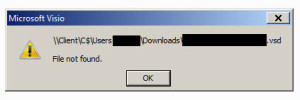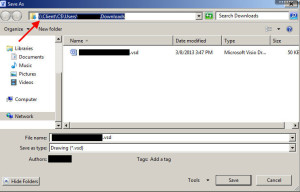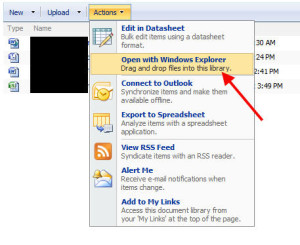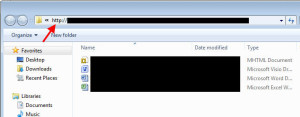Wow, long title there! Just like it says, I’m going to cover opening Sharepoint documents in a Windows 7 XenDesktop VDI session using XenApp published Office products with content redirection enabled. Here’s an example scenario:
- Your company uses Sharepoint and the URL is
http:\\sharepoint.domain.com. It is part of the Local Intranet zone in IE. - Your users are using Windows 7 VDI/XenDesktop VMs with Citrix Receiver Enterprise pulling published apps into the Start menu.
- You have Office 2010 products (Word 2010, Excel 2010, Visio 2010, etc) published via XenApp with content redirection enabled so .docx, .xlsx, .vsd files launched in the VDI session will open using the published Office app.
- Your users want to click on a Word, Excel, Visio, etc. document in a Sharepoint document library and click the Edit button to edit the document instead of just Read Only. They expect the published Office app to launch and allow them to edit the document.
THE PROBLEMS
In this scenario, when the user clicks on let’s say a Visio document in Sharepoint, the published app will launch but the document will not be sucked in. You’ll get a “File not found” error and if you look closely, the URL begins with “\\” as if it’s a UNC path instead of an HTTP path:
If you click OK, Visio will open but no diagram will open.
If you right click, Save As the Visio diagram to your C: drive and attempt to open it locally, it will launch the published Visio instance but will give you the following “File not found” error:
Again, look closely. It says “\\Client\” instead of your VM’s name.
THE FIXES
Well, really it’s 1 fix and 1 workaround for now. Let’s start with the fix first. We’re going to get local files and files residing on network shares launching right using the published app. I’m going to use Visio and a .vsd file again as the example:
1. On the Windows 7 VM, you must enabled Native Drive Mapping to be able to launch the .vsd file via published Visio. You can follow the CTX article here to make the registry change:
http://support.citrix.com/article/CTX130378
or you can enforce it via group policy. One thing though, on Windows 7 x64 the path is:
HKEY_LOCAL_MACHINE\SOFTWARE\Wow6432Node\Citrix\ICA Client\Engine\Configuration\Advanced\Modules\ClientDrive
NativeDriveMapping
Reg Type: REG_SZ
Add the Value: True
Once the value is set to TRUE, try launching the .vsd file you saved to your hard drive or on a network share. It will launch immediately. Then go to File – Save As in Visio and checkout the path bar. It will say “\\Client\C$\Users\xxxx\“. So now your system recognizes the word “Client”.
This is because you’re going through 2 virtualization layers. Citrix has an excellent article detailing how Client drives are passed through multiple sessions here:
http://support.citrix.com/article/CTX127872
You can also read more about the NativeDriveMapping key here:
http://support.citrix.com/article/CTX124389
Additionally here is a really good CTX article from Citrix that covers Client Drive Mapping troubleshooting that might be helpful to you:
http://support.citrix.com/article/CTX238200
And some info describing differences in Client drive mapping between the different versions of XenApp and Presentation Server here:
http://support.citrix.com/article/CTX127614
2. Now back to Visio diagrams in Sharepoint. First you need to verify content redirection is behaving correctly. In my case, I needed to make sure to change the published app location to include the “%**” switch. By default when you enable content direction, it will be:
"D:\Program Files (x86)\Microsoft Office\Office14\VISIO.EXE" "%*"
with just one asterisk. You need to add two so it looks like this:
"D:\Program Files (x86)\Microsoft Office\Office14\VISIO.EXE" "%**"
The reason for this is documented in this CTX article:
http://support.citrix.com/article/CTX116887
This was written for Presentation Server 4.5 but it still applies to XenApp 6.5 just fine.
Once you get content redirection squared away on your XenApp server, things will still not work correctly unfortunately when opening docs in Sharepoint in your XenDesktop session. You can try right clicking and editing but you will still get the File not found error. This error has nothing to do with Client Drive Mapping. Being a Sharepoint Architect in a previous role long ago, my gut feeling was this is a WebDAV issue. Remember, Sharepoint uses WebDAV with document libraries though to the casual observer it might appear to be a UNC file share path. My gut was telling me Receiver was not handling WebDav paths correctly and was treating them like regular SMB file share paths. No proof this is the culprit just yet, only a hunch.
Let’s run an experiment. In your Sharepoint document library, click Actions > Open with Windows Explorer:
You’ll notice the path bar says “http://sharepoint.domain.com” when you open it here:
Go ahead and launch the Visio diagram in this document library. When you try and launch it, it will launch published Visio and give you the same File not Found error as before. In some scenarios even an Access Denied error though it never actually was able to find the file. Again, it is looking for “\\sharepoint.domain.com” instead of using WebDAV (or the DavWWWRoot keyword) which should be parsed like the HTTP protocol “http:\\sharepoint.domain.com“. Sharepoint Content Redirection is never going to work because Citrix Receiver doesn’t know how to get there. One work around is to tell your users to save locally, edit, then upload. But this is annoying and most users will complain.
I started thinking Mini Redirector (which is Microsoft’s WebDav client and part of the Windows 7 OS) was trying to hand-off the DavWWWRoot keyword in the URL to Receiver and Receiver didn’t know what to do with it. Looking at the URL though it didn’t even seem to be passing it through. It was as if it was passing a straight UNC path. Or maybe is was not talking to owssupp.dll which is required to interact with and edit docs in Sharepoint. Maybe somehow it wasn’t handing off through Receiver properly. Now I was really starting to go down the rabbit hole and before I dug further, I figured I’d give Citrix Support a call and see if they had any input.
I was able to talk to a XenApp support technician and a XenApp Developer who were both very knowledgeable. I explained my WebDav theory and we ran a little experiment. We ran Process Monitor from my Windows 7 workstation and attempted to edit a simple Word document in Sharepoint. The published version of Word launched as expected and failed to find the file. Here is the URL that was passed to the PNAgent when we used the Process Tree display:
You can see that it passed:
\\Client\\\sharepoint.domain.com\link\to\doc\repository\test jason.docx"
Looks a bit odd, doesn’t it? No wonder it can’t find the file.
Then we went to the XenApp server with Word 2010 installed locally, opened Internet Explorer, and navigated to the Sharepoint document library. When I clicked Edit on the Word document this time, this is what was passed to the locally installed Word:
And of course the Word document successfully launched. You can see it passed a nicely formatted HTTP URL:
http://sharepoint.domain.com/link/to/doc/repository/test%20jason.docx"
The XenApp Developer verified this was actually a bug and needed to be fixed. It may or may not be WebDav related, but he confirmed there is definitely a disconnect at the Content Redirection level via Sharepoint as I had suspected. It has been added to their bug queue to get taken care of.
In the mean time, his suggestion is to publish Sharepoint itself on the same server Office 2010 products are installed on (publish IE passing the Sharepoint URL during launch). This is a good workaround but may annoy a few users. I always hate publishing IE because of the stuff you have to do to lock down/harden the browser. People can get confused and start browsing to Youtube or other process intensive websites using this published instance of IE if you don’t completely lock down the allowed URLs. This can cause a severe impact on XenApp performance for all users on the box. If I limit tabs, then people start complaining they can’t open additional tabs and the helpdesk gets flooded with phone calls. So just keep that in mind if you use this workaround.
Another work around I found online is by Anthony Obi:
He has an issue where owssupp.dll was not being detected on the client system (because it wasn’t there) and added an extra menu item in his Sharepoint deployment to edit documents as a work around. He modified the new Edit action to launch some Javascript that talks to PNAgent.exe that then talks to the published Office instance and passes the correct URL. This might work as well for you but of course it requires a modification of your Sharepoint environment and end user training.
I will post here as I get updates from Citrix Support on this issue. It’s a fairly unique scenario but definitely not uncommon in the real world as application delivery and desktop virtualization continue to be separated through multiple layers.













Gerald
May 15, 2013 at 1:15 PM
Jason, great article, describes the problem exactly.
I have a published Desktop, we are using Citrix Receiver v2 on the published desktop, editing a document breaks when content redirection is enabled for these extensions. Turning off content redirection will limit other functionality.
I hope that Citrix is able to resolve this issue with content redirection. Did you find a resolution to this?
Jason Samuel
May 15, 2013 at 1:29 PM
@Gerald
Hi Gerald, not yet. I actually spoke to our local Citrix SE about this “multiple hop” issue through the different virtualization layers just last week. We ran into an HDX 3D Pro issue attempting to go through multiple layers/hops and still retain a quality GPU accelerated video stream. One hop or layer is always fine but trying to go from physical client to a XenDesktop VM session and then run a XenApp application and still have it all talk perfectly is a pain point they are aware of. He mentioned there will be some announcements at Synergy that will help alleviate some of the these issues. I’ll post here if I hear anything new.
Ian Sheaprd
August 21, 2015 at 10:28 AM
Jason, any further updates? We’re having this same issue on XA/XD7.5 deployment.
Jean-Philippe Bergeron
September 23, 2015 at 1:39 PM
Hello, I’m facing the same problem, any updates ?